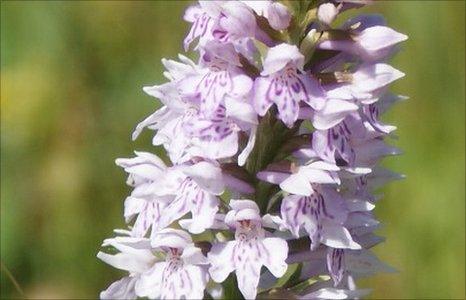Rugby pitch hay meadow in bloom at Plas Newydd
- Published

The markings on a northern marsh orchid
Visitors to a heritage site on Anglesey are being given a rare chance to see meadows as nature intended - but only for the next few days.
A former rugby pitch on the banks of the Menai Strait on Anglesey has been allowed to revert to nature.
The five acres, at the National Trust's Plas Newydd, now has a wealth of grasses and flowers, including orchids.
Guided walks are being offered at the site for just one week, before it is handed back to the farmer to harvest.
According to the National Trust 97% of traditional hay meadows have been lost in last 80 years.
Plants and flowers, many of which were probably always there but never allowed to grow tall enough to flower when the land was used as a rugby pitch, have burst into bloom.
Among the plants are hay rattles, common sorrel, chickweed and ox-eye daisies, a flower now more commonly seen on roadsides.
Rarer, more exotic-looking flowers, have also made an appearance including a clutch of orchids, such as the common spotted orchid, and northern marsh orchids.
The most unusual is the butterfly orchid though, with only one being found on the five-acre site.
"Just a few years ago the most common thing to see on the hay meadow was cadets playing rugby, as the field was used by the merchant navy training school, HMS Conway," said Gwenno Griffith from the National Trust.
'Rich nectar source'
"But for the past few years it has been left unfertilised with a crop of hay taken in August, and it is now a wonderful display of flowers," she said.
According to the Trust the revolution in grassland farming, with its cycles of ploughing and re-seeding and extensive use of fertilisers and herbicides, has resulted in a dramatic loss of flower-rich meadows.
Helen Buckingham, National Trust nature conservation advisor, said the hay meadow at Plas Newydd provided a rich nectar source in early summer, when compared to species-poor improved grassland.
"The meadows are often alive with butterflies, burnet moths and bees and are also an important habitat for birds, providing both feed and nesting sites, particularly for species such as the skylark," she said.
The changing appearance of the meadows were also evocative of changing seasons and the link between nature and farming, she said.
"The diversity of our meadows depends on a complex interaction between natural factors such as soils, water levels, geography and the idiosyncrasies of people and place," Ms Buckingham added.
"In the conservation of our meadows these things need to be taken seriously too - we ignore this at our peril if we want our meadows to remain and pass them on as a wildlife and cultural bequest to future generations."
The Plas Newydd hay meadow guided walks will be held at 1230 BST and 1430 BST from Saturday 19 June until Wednesday 23 June.